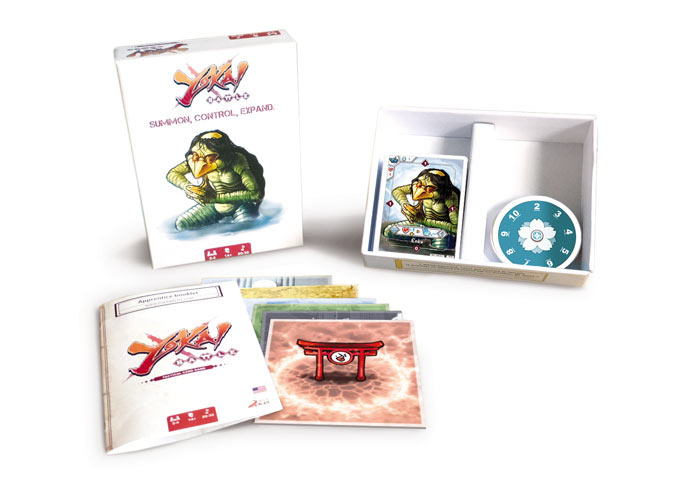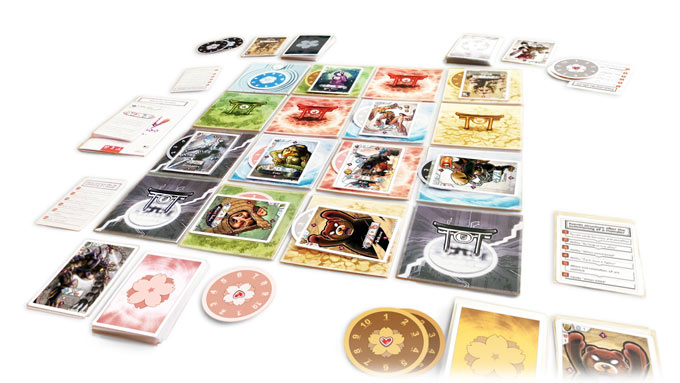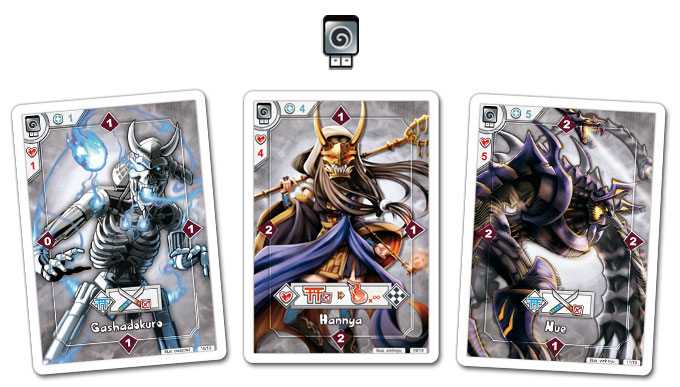In case you missed last week’s press release, “Yokai Battle” is on Kickstarter and looking for your support. In short, it’s a strategic card battler featuring Japanese occult monsters. The idea is to be the first player to conquer five terrain cards by summoning these monsters onto them. Of course, it wouldn’t be a battle without all sorts of weird looking monsters that possess varying abilities (called “jutsu”). Before we dive into this preview, I’d like to thank Arno Guenshérian from Moe Blaze for reaching out and providing me with a press copy. It’s important to stress that I received a PnP (print-and-play) prototype, meaning that everything you’re about to read about is subject to change. In my experience, most prototypes are not reflective of the final product. With that said, I’ll be featuring pictures provided by the developers to give you a better taste of what you’ll get should you support the game.
*Editor’s Note: The game can be played as a free-for-all no matter how many players you have. If you decide to split up into teams, then you’ll need a total of four players to start a 2 vs 2.
Setting everything up is fairly easy, though the board will be assembled / configured based on the number of players. In a two player game for example, two terrain cards per element are shuffled and placed in a 3×3 row. Yes, you’ll have some left over…these are simply discarded. There’s a chakra meter, which starts on the “2” and is placed nearby. Each player receives a deck of 22 cards and draws five cards to form their starting hand. Players who don’t have at least two cards with a chakra cost of “1” should redo the shuffle & draw. This ensures that players will be able to play/summon something on their first few turns.
The game is played over a series of rounds. At the start of every round, the chakra meter is increased by one (allowing players to play cards with a higher cost as the game progresses). This mechanic is similar to Hearthstone, if you’ve every played that card game (by Blizzard Entertainment). Every round, the game is played in turns in clockwise order. A player’s turn consists of the combat phase and the draw phase (AKA turn closure). At the end of a round, a player’s chakra points are reset to zero, meaning none carry over to the next round.
During the combat phase, players spend their chakra points to either summon monsters or attack enemy monsters with ones already on the board. Players don’t lose chakra points when summoning, they simply have to observe their round limit. Again, this limit increases by one every round. No more than two monsters can be summoned per combat phase and only one monster can be summoned per terrain card. The draw phase is very quick as the player simply draws up to five cards. After that, the next player in clockwise order takes their turn.
Now that you know how a typical round plays out, we’re able to get into the meat and potatoes of the game…the monsters. Besides having a chakra cost, each monster has numeric values on all four sides of their card, indicating their attacking strength on that particular side. This makes monster placement incredibly strategic…after all, you wouldn’t want a monster’s strongest side to be facing the edge of the grid. Luckily, summoned monsters can be placed in any orientation horizontally or vertically in order to direct its strongest sides to where you need them. Tread carefully though, monsters cannot move or change positions once summoned. A summoned monster starts with full health (or Life Points), which is done via a life-counter disc that is placed under the card.
It’s not enough to simply pay attention to the monster’s prefered sides when it comes to attack strength…monsters have a favorable element in which they prefer to be summoned. A monster summoned on a terrain card of the same element receives a few bonuses: 1) its ability can be used and 2) 1 LP is added to its listed LP value. Alternatively, summoning a monster onto an element it doesn’t find favorable means that you won’t be able to use its ability and also lose 1 LP. Colorless monsters do exist for those curious, meaning they aren’t affected by terrain colors/types.
Attacking another monster is fairly straight forward, though there are a few rules to remember. For one, attacks happen simultaneously meaning that both monsters receive damage at the same time based on their side’s attack strength. Monsters who are summoned next to one or more enemy monsters MUST choose one to attack. After that, the player can keep attacking if they so choose (at the cost of chakra points equal to the summoning cost)until either one of them is destroyed or until they’ve stopped voluntarily. Life points are adjusted as appropriate.
While experienced card battler players won’t find a lot of new concepts here, I think the biggest draw here is the art style and the abilities that the monsters possess. There are a number of different triggers and abilities, like being able to draw extra cards, increasing AP, and so on. This variety serves to introduce strategies one normally wouldn’t consider. For example, triggers involving “when killed” may prohibit an enemy from drawing cards. It could be useful to sacrifice such a monster by putting it into a bad position in order to limit your opponent on their next turn. Likewise, triggers such as, “as long as it is alive” will encourage you to play defensively in order to maintain its ability for as long as possible.
I think “Yokai Battle” could be very popular, given enough support. Its short play time appeals to me, not to mention I don’t have to consult a chart every time I want to summon or breed a water Pokémon. In other words, it’s very easy to pick up and play for a card battler. The monsters have an appeal about them and the artwork is very well done. I personally can’t wait to see what the final product will look like.
—
You can learn more about and support “Yokai Battle” by visiting its Kickstarter and Facebook page, here:
https://www.kickstarter.com/projects/mbz/yokai-battle
https://www.facebook.com/moeblaze.editions
—



